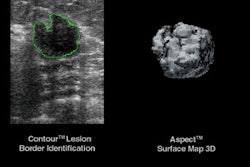
VIENNA - In a study of two competing microbubble-based ultrasound contrast agents, the bigger bubbles won. A joint study by Necker Hospital in Paris and the Sunnybrook Health Science Centre in Toronto found that Optison (FS069, Mallinckrodt, Hazelwood, MO) produced higher Doppler signal intensity than Levovist (Schering, Berlin).
"The purpose of our study was to quantify the Doppler signal enhancement during the injection of two different contrast agents," said Dr. Jean Michel Correas of Necker Hospital in a presentation yesterday at ECR 2002. "The purpose was to calculate the dose response, and to quantify the Doppler signal."
The Optison agent is based on the uptake of proteinaceous microbubbles encapsulated with a human seroamalgamate, Correas said. "These microbubbles have a mean diameter of 224.5 micrometers," he said. "They have a very strong harmonic response, but no mechanical effects. Levovist is based on air microbubbles with a mean diameter of 4 micrometers, with a strong harmonic response, and, in this case, high mechanical effects."
In the study, 24 patients received 2 intravenous bolus injections of Optison, randomized at 1, 2, 3, and 4 ml. Each patient received just one injection of Levovist (2.5 g, 5 ml, 400 mg/ml) in the same vein as the Optison.
The 4-MHz probe was designed in-house in an effort to minimize wrist-movement artifacts commonly referenced in the literature, Correas said. Continuous Doppler signals from the radial artery were captured in quadrature, and digitized on a Macintosh Power PC 7300.
The researchers used the MathLab application to calculate the mean duration of the enhancement, peak enhancement, and the area under the time-intensity curve (AUC). Wrist-movement artifacts prohibited the analysis of 3 patients.
According to the results, the duration of enhancement (mean plus standard deviation) was 255 ± 50 seconds for the Levovist, and 307 ± 93, 304 ± 78, 301 ± 85 and 386 ± 97 for each dose of Optison (1 ml, 2 ml, 3 ml, and 4 ml)
"The dose response with Optison showed a linear relationship between the dose and the peak enhancement, and we can see that the standard deviation was obtained in all cases," Correas said. "The duration of the enhancement was not much different (between) the 1 ml, 2 ml, and 3 ml groups, with a slight increase for the 4 ml groups."
As measured in linear units, the AUC was respectively 5009 for Levovist, and 6311, 10765, 13522, and 15854 for each dose of Optison (1-4 ml).
"When we evaluated the area under the curve, we were happy to observe that there was a linear relationship between the AUC and the dose of Optison," (r > 0.97) he said. "The peak enhancement was slightly increasing with Optison and was significantly lower with Levovist." Levovist also showed a larger variability between patients, Correas said. "The standard deviation was even higher than the measurement that we obtained," he added. Results did not vary based on the weight of the subject.
"In conclusion, Doppler intensitometry is feasible for improving training for (the use of) ultrasound contrast agents in routine practice," Correas said. "It can provide a curve of enhancement in a patient, and so you can rely on your imaging results based on the Doppler signal intensity. A linear relationship was observed between the dose and the area under the curve for Optison, and these results proved that the model that we're using is correct. These results are only exploring the linear results of the contrast agents. For Optison, we observed a lower variability compared to Levovist."
Correas emphasized that the results would not necessarily correspond with results obtained in nonlinear imaging techniques, such as pulse inversion.
By Eric BarnesAuntMinnie.com staff writer
March 6, 2002
Related Reading
Ultrasound with Levovist in the diagnosis of suspected calf vein thrombosis, August 6, 2001
Nycomed Amersham expands ultrasound efforts as Mallinckrodt exits sector, August 6, 2001
Contrast agents for US induce capillary rupture in mice, August 24, 2000
Flash echo with contrast improves ultrasound detection of liver lesions, April 24, 2000
Copyright © 2002 AuntMinnie.com


















